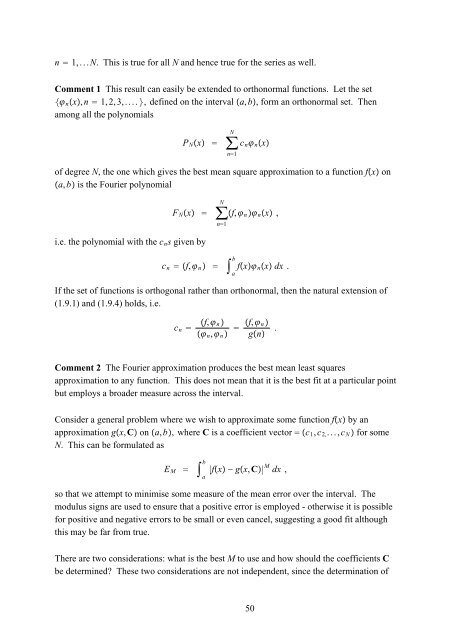Fourier Series
Fourier Series
Fourier Series
You also want an ePaper? Increase the reach of your titles
YUMPU automatically turns print PDFs into web optimized ePapers that Google loves.
n 1,...N. This is true for all N and hence true for the series as well.Comment 1 This result can easily be extended to orthonormal functions. Let the set n x,n 1,2,3,...., defined on the interval a,b, form an orthonormal set. Thenamong all the polynomialsP N x N∑ c n n xn1of degree N, the one which gives the best mean square approximation to a function fx ona,b is the <strong>Fourier</strong> polynomialF N x N∑f, n n x ,n1i.e. the polynomial with the c n s given byc n f, n abfxn x dx .If the set of functions is orthogonal rather than orthonormal, then the natural extension of(1.9.1) and (1.9.4) holds, i.e.c n f, n n , n f, ngn.Comment 2 The <strong>Fourier</strong> approximation produces the best mean least squaresapproximation to any function. This does not mean that it is the best fit at a particular pointbut employs a broader measure across the interval.Consider a general problem where we wish to approximate some function fx by anapproximation gx,C on a,b, whereC is a coefficient vector c 1 ,c 2, ...,c N for someN. This can be formulated asE M ab|fx − gx,C| M dx ,so that we attempt to minimise some measure of the mean error over the interval. Themodulus signs are used to ensure that a positive error is employed - otherwise it is possiblefor positive and negative errors to be small or even cancel, suggesting a good fit althoughthis may be far from true.There are two considerations: what is the best M to use and how should the coefficients Cbe determined? These two considerations are not independent, since the determination of50
















